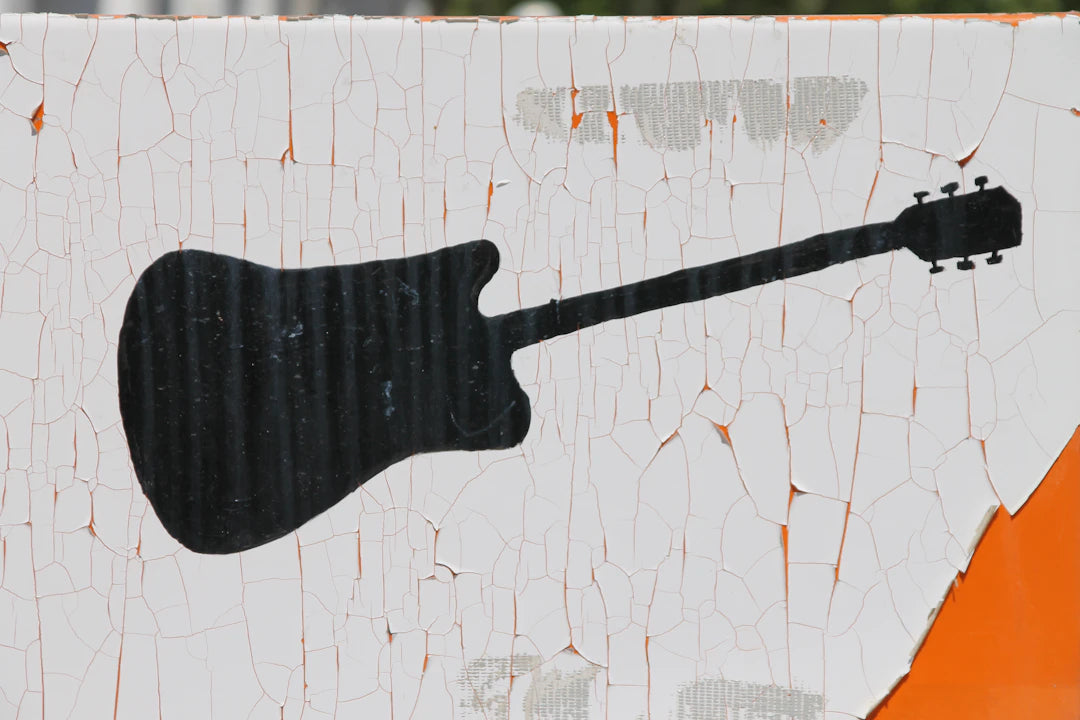Overview
Explore the evolution of guitar painting, from its historical roots and early finishes to modern techniques like airbrushing and digital printing. Discover how aesthetics influence sound quality, the role of sustainability, and the emotional connection musicians have with their instruments. Learn about guitar refinishing processes and the future of artistic expression in guitar craftsmanship. Embrace your creativity and let your guitar reflect your musical journey.
Frequently Asked Questions
1. What are the historical roots of guitar painting?
2. How did the introduction of nitrocellulose lacquer change guitar finishes?
3. What are some modern techniques used in custom guitar painting?
4. How does the finish of a guitar affect its sound quality?
5. What is the process of guitar refinishing?
The guitar has long been more than just an instrument; it’s a canvas for self-expression. Over the decades, various painting techniques have evolved alongside technological advancements, enabling luthiers and hobbyists alike to create stunning guitar finishes. From the early days of solid colors to today's intricate designs, the history of guitar painting techniques showcases creativity and innovation. In this article, we will explore the journey of guitar painting, focusing on its historical roots, evolution, and how it connects to other guitar craftsmanship like guitar refinishing and the importance of interior elements such as Telecaster guitar pickups.
The Origins of Guitar Painting
In the beginning, guitars were often crafted from natural wood, leaving them with a rustic appearance. Luthiers focused on enhancing the wood’s grain rather than adding complex finishes. However, as popular music evolved, so did the visual demand for more vibrant and stylized instruments.
The Early Days of Finishing
In the late 19th century, European craftsmen began to experiment with varnishes and lacquers to protect wooden instruments. These early finishes were primarily functional, as they prevented damage from moisture and wear. However, they soon allowed for stylistic expression that began to define different manufacturers' guitars. During this time, manufacturers started to offer various colors and tones, paving the way for the artistic endeavors that would follow.
The Rise of Color in the 20th Century
The 20th century saw a massive explosion of guitar innovation. With the emergence of iconic brands, players wanted their instruments to reflect their musical identity. The use of color in guitar finishes became a statement in its own right. Louis Electric Guitars and Fender began using bold colors that aligned with the rock 'n' roll culture of the time.
Introduction of Nitrocellulose Lacquer
In the 1950s, manufacturers began using nitrocellulose lacquer, a popular choice for its fast-drying properties and durability. Nitrocellulose allowed for deep, glossy finishes that emphasized the wood grain while offering an extensive palette of colors. This period introduced some of the most iconic finishes in guitar history, including the famous ‘Fiesta Red’ and ‘Surf Green.’
The Significance of the Telecaster
One of the most notable guitars from this era is the Telecaster, introduced by Fender in 1950. The Telecaster, with its distinct shape and rich tone, became a favorite among musicians. As its popularity surged, players sought custom aesthetics to match their sound. Thus, guitar refinishing became a burgeoning field, leading to artists customizing their Telecaster guitar pickups’ performance and the instrument's overall look.
Techniques of Custom Guitar Painting
As guitar culture grew, so did the methods used to paint them. Artists have developed numerous techniques influencing how guitars are finished and customized. Let's explore some of the most prominent painting methods that showcase guitar artistry.
Airbrushing Techniques
Airbrushing emerged as a favored method for guitarists looking to create detailed designs. This technique allows artists to blend colors smoothly and produce intricate images, including portraits, landscapes, and abstract art. Many famous guitars adorned with elaborate airbrush graphics have become legendary in rock and pop culture.
Graphic Overlay and Decals
Decals and graphic overlays gained popularity in the 1970s and 1980s. This technique allows for complex designs and branding without the labor-intensive task of painting each instrument by hand. Manufacturers would apply intricate graphics directly onto the guitar's finish, creating a unique aesthetic while leaving room for different paint finishes underneath.
Relic and Aging Techniques
The relic approach has become incredibly popular among players who prefer a vintage look without the wear and tear associated with age. This technique involves artificially aging the guitar's finish to mimic the feel of a well-loved instrument. Relic finishes often expose the wood beneath, offering character and appeal to guitarists who value authenticity.
The Modern Era of Guitar Painting
With the advent of technology and the changing landscape of music, the methods of guitar painting have evolved. However, the core principles remain consistent—creativity, attention to detail, and a commitment to craftsmanship.
The Role of Sustainability
Today, some luthiers are focused on sustainability by using eco-friendly paints and finishes. Knowing the environmental impact of certain materials, many craftsmen opt for water-based lacquers and non-toxic finishes. Not only do these methods benefit the environment, but they also provide a unique look and feel to each guitar.
Incorporating Technology and Innovation
Digital printing technology has also made waves in guitar painting. With the ability to create high-resolution images directly onto the guitar body, artists and manufacturers can achieve extraordinary detail. This matches the intricate designs often seen in modern art, bringing a new layer of creativity to guitar aesthetics.
The Interplay with Guitar Components
As guitar painting techniques have evolved, so has the connection between aesthetics and functionality. The visual appeal of a guitar can enhance the overall performance experience, particularly with technical aspects like Telecaster guitar pickups and electronics.
Finishes and Sound Quality
While many players focus on sound and comfort when choosing their guitars, the finish can influence the tone. The type of finish can affect how resonance travels through the wood. For example, heavier finishes may dampen the natural vibrations of the wood, altering the tonal quality. Those seeking rich, authentic sound often notice such differences, emphasizing the necessity of both visual and auditory appeal.
Emotional Connection
A guitar's aesthetic plays a significant role in the player's emotional connection to their instrument. Many musicians believe that the look of their guitar can inspire creativity and performance. A stunning finish may spark ideas during songwriting, connecting the musician with their art and their audience.
The Final Touch: Guitar Refinishing
For those who love their guitars but seek a fresh look or additional enhancement, guitar refinishing becomes a practical solution. This process can revitalize an aging instrument, making it feel brand new while retaining its historical essence. Refinishing allows for artistic expression and functional enhancements, helping guitarists obtain their dream instrument.
Steps Involved in Guitar Refinishing
Guitar refinishing generally involves several steps that ensure the final product meets the player's expectations:
- Strip the Old Finish: The current finish is removed using chemical strippers, sandpaper, or heat techniques, unveiling the underlying wood.
- Prepare the Surface: Once stripped, the surface is sanded to create a smooth finish, ready for the new coat.
- Choose the Finish: Depending on the desired outcome, options include nitrocellulose lacquer, polyurethane, or oil finishes.
- Apply the Finish: The new finish is carefully applied, allowing each coat to dry and be sanded between applications.
- Finalizing Touch: After achieving the desired thickness and polish, a final buffing completes the refinishing process.
The Future of Guitar Painting
The future of guitar painting holds exciting possibilities. As artistry and technology continue to intersect, guitar finishes will become increasingly innovative. Artists will push boundaries, adopting advanced techniques while preserving traditional craftsmanship.
Perhaps a Cultural Shift
As a community, guitarists are becoming more aware of the significance of their instruments beyond sound. They now consider aesthetics, emotional attachment, and environmental impact when selecting guitars. This cultural shift will likely motivate luthiers and manufacturers to approach guitar painting holistically, integrating sustainability practices with artistic endeavors.
Embrace Your Inner Artist
Whether you are a musician, artist, or simply an enthusiast, understanding the history and techniques of guitar painting can inspire you to explore your creativity. As you navigate your guitar journey, remember that every strum, stroke, and technique tells a story—a story that is uniquely yours.
At Mythic Guitars, we celebrate the artistry of guitars and encourage you to express your passion through creativity. Whether you’re considering guitar refinishing or simply love the allure of beautifully painted instruments, there is a world of artistic possibilities waiting for you. Embrace your creativity, and let your guitar reflect the music you create!
Linked Product

Odyssey Solstice Tele Neck SC
The Odyssey Solstice Tele Neck SC offers musicians a reliable option for achieving a warm and articulate tone, ideal for a variety of genres including country, blues, and Americana. Its hand-wound construction and Alnico V magnets enhance harmonic complexity, ensuring consistent performance with a classic Telecaster sound. This pickup is designed for those seeking to enhance their guitar's tonal range while maintaining vintage character.
View ProductExplore the world of another Shopify or Wix store owner. Visit their captivating online store. Keep in mind that this is a promotional link, and we are not responsible for the content of the linked store.











